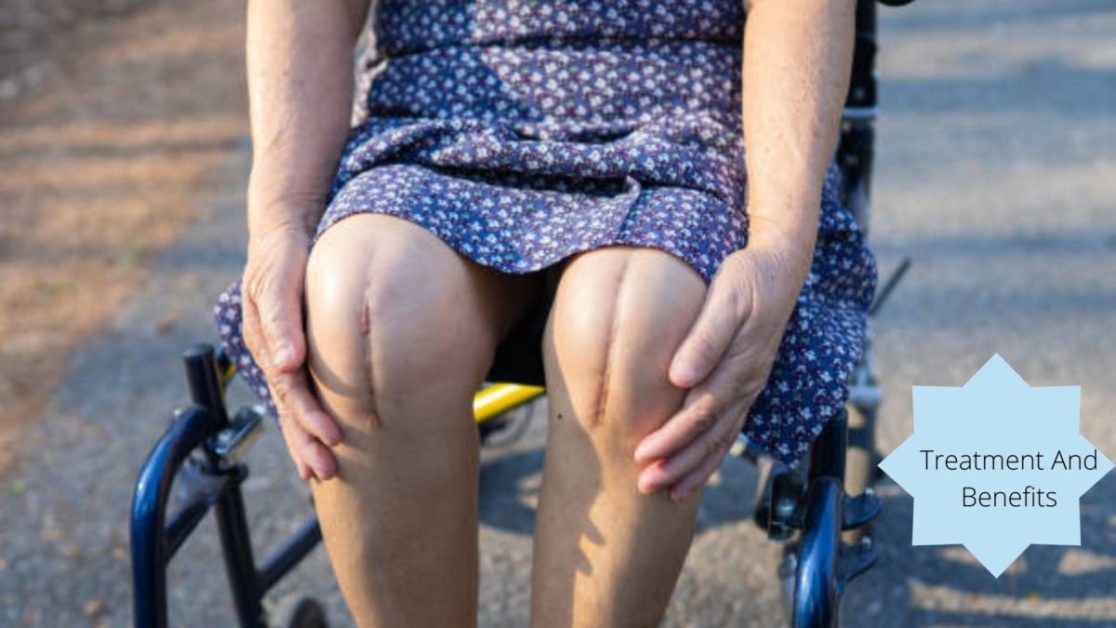How Painful Is Total Knee Replacement-Treatment And Benefits Of Surgery

For many people, knee arthritis and joint pain can make getting around difficult, and even painful. At first, some simple tasks like walking, climbing stairs, and kneeling may be difficult. But after a while, these everyday routines become too painful. If you reach this point, you may need to consider total knee replacement surgery.
About Knee Replacement Surgery
This surgery is a surgical procedure that replaces damaged or worn-out knee cartilage with artificial components. The goal of this surgery is to relieve pain and improve function.

Knee replacement surgery can be performed as a total knee replacement or as a partial knee replacement. A total knee replacement involves removing the entire joint surface of the damaged bone ends and replacing them with a metal-on-metal or ceramic-on-ceramic implant. In contrast, a partial knee replacement only replaces part of the damaged joint surface. This procedure may be used if there are only small areas of damage in one knee, but more often it is used when both knees are affected by arthritis and need to be replaced at the same time.
During either type of surgery, the surgeon will make an incision over the front of your thigh or rear side of your thigh depending on how much of your own bone needs to be removed during surgery and whether you have other issues with your leg that require additional work before performing your knee replacement procedure.
Difference Between Partial Knee Replacement And Total knee Replacement
Partial knee replacement is a surgical procedure in which only the damaged portions of the knee joint are replaced with prosthetic components. This surgery is suitable for patients who are not ready for total knee replacement or those who can’t undergo total knee replacement due to medical conditions.
In a partial knee replacement, only a portion of the damaged cartilage and bone is removed and replaced with prosthetic components. The surgeon removes part of the thigh bone (femur), the kneecap (patella), and the shinbone (tibia). The surfaces of these bones are then prepared so that they can be joined together by the prosthetic joint. In some cases where the joint surface is too narrow to accommodate a full-sized prosthesis, a smaller-sized joint may be used instead.
Total knee replacement is a surgical procedure in which the damaged ends of the thighbone and lower leg bones are removed and replaced by high-strength artificial surfaces. The artificial surfaces (called components) are made of metal alloys, such as cobalt-chrome, titanium, or stainless steel. The prosthetic knee joints may also be made of a more durable plastic material called polyethylene.
In total knee replacement surgery, both the upper and lower portions of the joint (the femur and tibia) are replaced. This type of surgery is often done to relieve pain associated with arthritis or to improve mobility and quality of life.
Benefits Of Knee Replacement Surgery
Patients who have undergone a knee replacement operation have reported several benefits of the procedure. These include:
?Pain relief – Knee pain can be debilitating. Patients who have had knee replacement surgery report that their pain is reduced or eliminated after the procedure.
?Improved mobility – The overall range of motion of the knee joint is improved after surgery, allowing patients to get around more easily.
?Improved quality of life – The ability to engage in activities such as walking and climbing stairs without pain can greatly improve your quality of life.
?Improved appearance – Patients who undergo knee replacement surgery often report that their knees look better following the procedure.
?Longer-lasting results – Knee replacements are designed to last for many years and can even last for decades if properly maintained by the patient (and their doctor).
How To Treat pain After Knee Replacement Surgery
The main goal of treatment is to relieve your pain and get you moving again as soon as possible. The following treatments can help:
Swelling
Swelling is a common side effect after knee replacement surgery. Swelling occurs when fluid accumulates in the space around the joint. This fluid can come from several sources, including blood, lymph, and body fluids.

To help relieve swelling:
Rise slowly from a sitting or lying position — don’t jump up or walk too fast.
Don’t bend at the waist while standing or walking; keep your back straight and hips level while bending at the knees only.
Don’t cross your legs while sitting (crossing them will put added pressure on your new knee).
Bruising

Bruising after knee replacement surgery is common. It’s usually caused by blood vessels under the skin breaking or leaking. Bruising can also occur with any type of surgery, including hip replacements.
The best way to prevent bruising is to take steps before and after your surgery to make sure your blood stays healthy.
Follow a healthy diet. Eating foods that contain iron helps keep your red blood cells working properly. These include beef, chicken, and fish. Iron supplements are also available but talk to your doctor before taking them because they can interfere with other medications you may be taking.
Get plenty of rest and avoid lifting heavy objects for at least a week after surgery. This will help reduce the risk of bleeding under the skin from broken capillaries (tiny blood vessels).
Home Treatments
Home treatments are a great way to get back on your feet after knee replacement surgery. You can use them while you’re waiting for your doctor’s appointment, or as part of your post-op recovery.
Most patients will be able to start physical therapy within a few weeks of surgery. Your therapist will help you stretch and strengthen your leg muscles so that they can handle the added weight of the new knee implant.
Here are some home treatments you can try:
Here Are Some Home Treatments You Can Try:
- Ice packs: Use ice packs on your knee at least once every four hours when you’re awake, for 15 minutes at a time. This helps reduce swelling and pain.
- Compression stockings: Wear compression stockings to keep blood from pooling around your thigh muscles and calf muscles during activity. Blood pressure cuffs work well for this purpose since they’re inexpensive and readily available in drug stores.
Physical Therapy
When you have knee replacement surgery, you can expect your doctor to prescribe physical therapy. The goal of physical therapy is to help you regain strength, movement, and flexibility. Your physical therapist will teach you exercises that can help relieve pain and prevent problems from developing.
Physical therapy involves exercises and stretches designed to improve strength, flexibility, and balance. Your therapist may also use special tools, such as exercise balls and resistance bands, to help increase your range of motion.
Exercises
After knee replacement surgery, you may be able to do many of the same activities as before your surgery. However, it’s important to wait until your doctor has given you the okay before starting any exercise program.
Light exercise is typically recommended for people who’ve had a total knee replacement. This includes:
Light Exercises
- Walking. Your doctor may recommend that you walk several times a day for a few minutes at a time. Your doctor may recommend that you walk several times a day for a few minutes at a time.
- Range-of-motion exercises. Your doctor will show you how to do these exercises and help you understand what you can and cannot do with your new knee joint.
- Swimming or water aerobics (if approved by your surgeon). These exercises are helpful because they don’t put weight on your new joint as much as land-based exercise does.
Knee replacement surgery recovery Time Period And Process
Before Surgery
Your doctor will discuss your condition, the procedure, and any risks or complications that may occur.
You’ll need to stop smoking at least six weeks before having knee replacement surgery. If you smoke, your risk of complications is increased.
You may be asked to lose weight if you’re obese or overweight. This can help reduce the stress on your knees and make it easier for them to heal after surgery. Talk to your doctor about how much weight loss is recommended for you.
You’ll also have tests done to check your overall health before the operation. These tests include:
Blood tests. Your doctor may order blood tests to check your liver and kidney function, as well as your blood sugar level, which can help determine if medication needs adjusting before surgery.
Heart tests (if indicated). If you have a heart condition that affects blood circulation in your legs, such as peripheral arterial disease (PAD), you’ll likely need heart tests before knee replacement surgery is considered safe for you. These tests measure how well blood flows through the heart and major arteries into the legs and feet, as well as how well oxygen reaches various parts of the body when walking on a treadmill at different speeds and inclines (stress test).
In The Hospital
After surgery, you will be taken to a recovery area where the nurses will monitor your condition. You may feel drowsy from medications and pain medication. You’ll be moved to a room on the orthopedic floor within 24 hours after surgery.
You will have an IV in your arm to give you fluids and pain medication. Your leg will be elevated on a pillow for the first few days after surgery so it doesn’t swell.
The length of your hospital stay depends on how well you do after surgery and whether any complications arise during your recovery phase.
First 2 Weeks
During the first 2 weeks after surgery, your doctor will want you to avoid driving and doing any activity that could put stress on your new knee joint. You may also be limited in what you can do around the house or at work until the doctor says it’s OK.
Your doctor will likely want you to stay in bed most of the day during those first few days after surgery. This allows your body to heal without putting stress on your new knee joint while it’s still vulnerable from surgery. You should try not to get out of bed except when necessary, such as going to use the bathroom or getting something from another room in your home.
Once you start feeling better and are able to get out of bed more often, you’ll need some help with basic activities like washing up and dressing (if possible).
2-6 Weeks
After knee replacement surgery, you may need to use a walker or crutches for a few weeks and then progress to using a cane. Your doctor will recommend physical therapy and exercises to help strengthen and improve your range of motion.
You’ll probably be able to return to work within two weeks after the procedure. You may have some swelling in your leg for several months following surgery. Your doctor may recommend wearing a compression bandage around your thigh for about 6 weeks after surgery.
As you recover from knee replacement surgery, it’s important to follow your doctor’s instructions about physical activity and rehabilitation. After your procedure, you’ll do most of the same exercises that helped improve mobility before surgery. These include deep squats and lunges, heel raises, calf raises, and bent-knee sit-ups.
After 3 Months
The first few weeks after surgery are the most critical because you’re still healing from the operation and learning how to use your new knee joint. If you overdo it during this period, you may experience complications such as infection or stiffness in your new knee joint that could lead to additional surgery.
After three months, you’ll likely be cleared by your doctor to start exercising again — but only if they think it’s safe for you based on your overall health and progress so far. It’s important that you listen carefully when they give instructions about what exercises are OK and which ones aren’t because they want your recovery process to go as smoothly as possible without causing any further damage or discomfort.
Alternatives To Knee Replacement Surgery
Knee replacement surgery is a common treatment for people who suffer from knee arthritis. The procedure involves removing bone and cartilage from the knee joint, then replacing them with artificial materials. Knee replacement surgery can relieve pain and improve mobility, but it is not without risks.
In some cases, people may be able to avoid knee replacement by choosing an alternative treatment. These treatments include:
- Physical therapy and exercise: Physical therapy and exercise can help strengthen the muscles around your knee to reduce pain and improve flexibility. Your doctor may recommend exercises such as squats, lunges, or stair climbing to increase strength in your hips, thighs, and legs. If you have limited mobility in one leg from arthritis or another condition, you can use a cane or crutches to help support yourself while exercising.
- Medications: Nonsteroidal anti-inflammatory drugs (NSAIDs) such as ibuprofen (Advil) or naproxen sodium (Aleve) can reduce inflammation in your joints and ease pain caused by arthritis. Some NSAIDs also thin blood so that clots don’t form easily in case of an injury during physical activity (such as falling down). Corticosteroids are another type of medication that may be helpful in reducing joint inflammation.
- Corticosteroid injections: These injections are used to treat osteoarthritis in knees only when all other treatments have failed to provide significant pain relief or functional improvement in at least three months’ time. The injections may provide temporary relief from pain but don’t improve function or reduce joint damage caused by osteoarthritis over time.
Final Thoughts
Even though the experience is about pain, you need to try and be positive. When you are going through a total knee replacement it’s important to remember that you are doing this for yourself and that your doctor has prescribed that you do this. If you get upset, depressed, or just mope around then you will only prolong the pain. The fact is that you need to look at the series of milestones that will occur during your recovery period with a positive mindset. Don’t fret over pain, simply take this time off as an opportunity to do what you have not been able to do before.
Dr. Edward Zelman
Dr. Edward Zelman is a distinguished and highly respected medical professional who has dedicated his career to the field of general medicine. With a profound commitment to patient care and a wealth of knowledge acquired over decades of practice, Dr. Zelman has earned a reputation as a trusted healthcare provider in his community. With a career defined by excellence and an unwavering commitment to the betterment of his patients and the broader community, Dr. Edward Zelman stands as a pillar of the medical field, dedicated to the principles of healing and compassionate care. At present, Dr. Edward Zelman is researching safe and effective natural remedies that can restore as well as maintain the youthful functioning of the body.
View All By Dr. Edward






